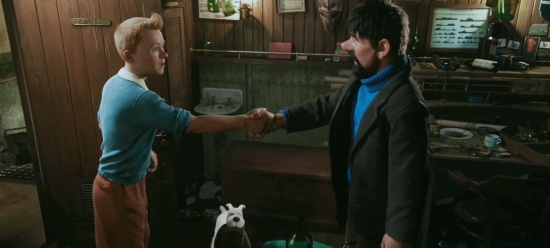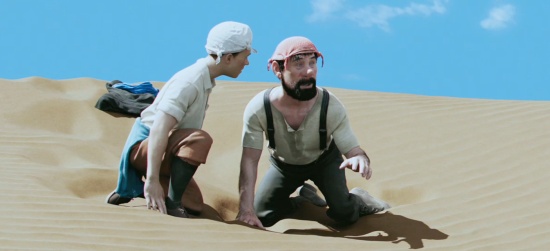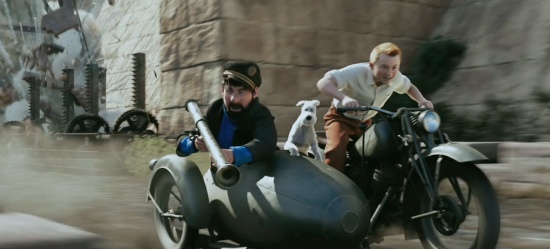The Adventures of Tintin (Steven Spielberg, 2011)

I don’t need to re-cap the level of anticipation to which I ascended in the lead-up to Steven Spielberg’s adaptation of Hergé’s classic comic strip series The Adventures of Tintin; my salivating is all preserved on-line. Getting worked up ahead of the fact is part of the fun with modern blockbusters, but it means that actually seeing the film can often be a let-down. Amongst the recent mega-franchises we probably have to go back to Peter Jackson’s Lord of the Rings trilogy to find one that truly lived up the hype; at the other end of the spectrum, and far more common of late, are wretched let downs like Steven Spielberg’s Indiana Jones and the Kingdom of the Crystal Skull. Tintin arrives heralded to the screen by both Jackson (as producer) and Spielberg (as director), so the form line for this was mixed. The good news is that their adaptation does justice to the source material and lives up to the expectations. I loved The Adventures of Tintin.
One of the key things that fuelled expectations was the talented triumvirate of geek favourites that Spielberg and Jackson had snared for screenwriting duties: Steven Moffat, Edgar Wright, and Joe Cornish. The trio have done well in forging a largely seamless hybrid of Hergé’s The Crab with the Golden Claws and The Secret of the Unicorn, with a few small details from other books thrown in for good measure. The start of the film recalls the tone of Hergé’s earlier Tintin stories, with Tintin entering into an adventure accompanied only by his brave and faithful dog Snowy; in the latter portions, Tintin meets and then teams up with the irascible drunkard Captain Haddock. Their quest is to locate a series of parchments which, together, will provide a clue to the location of a hidden treasure; racing them to the target is the murderous Sakharine. The adventure takes Tintin from Europe to north Africa and back again.
Hergé’s comics are full of action and humour, and his drawings were intensely cinematic. They should, therefore, have been ripe for Hollywood adaptation long before now. Yet the depiction of the hero raises difficulties. Tintin can appear grotesque if done in live action, and while hand-drawn animation is a natural fit, previous animated adaptations have lacked the budget to really do justice to the scope of Hergé’s world. Jackson and Spielberg have instead opted for performance captured computer animation, and this is an approach I have been underwhelmed by in the past. My concern is that the technique can have something of a neither-fish-nor-fowl quality, lacking the freedom of true animation but forsaking the tangibility afforded by live action; it has been dispiriting to see once talented directors such as Robert Zemeckis give up years of their careers to it.

Yet it works beautifully here. Somehow, the technicians at Weta have managed to convey much of the feel of Hergé’s art in this very different medium. The environments are particularly good, with the early Belgian scenes having a lustrous retro sheen to them, and the desert scenes (such as that above) corresponding very closely to the equivalent panels from The Crab with the Golden Claws. The characters fare surprisingly well, too: somehow they remain faithful to the comics’ conception despite the photorealism of the technology seeming, conceptually at least, to be a poor match for the elegant graphical shorthand of Hergé’s drawing. Crucially, the uncanny valley effect that was so apparent throughout the Zemeckis performance capture films is much less troubling here. The technology still isn’t perfect, but it’s certainly good enough to make the characters appealing. Jamie Bell’s Tintin is boyishly earnest, as he should be, and Andy Serkis’ Haddock steals the show, as Haddock should in any decent Tintin adaptation. (Tintin’s faithful dog Snowy is realised through non-motion-captured animation and is both intrepid and appealingly dog-like).
The other truly pleasant surprise is how the technology has liberated Spielberg. It might have been expected to bring out the worst in him, stripping the last vestiges of realism and spontaneity from his filmmaking: after all, one of the biggest problems with the last Indiana Jones was its pervasive computer-generatedness. Yet it may be that a production like that or the Star Wars prequels – with live action actors flailing around in heavily digitised environments – is the true example of the unsuccessful grey area between live action and animation. Somehow, this new hybrid medium has allowed Spielberg to be much more playful and inventive than he was for Indiana Jones and the Kingdom of the Crystal Skull. For something that is so meticulously assembled, the film manages to have a surprisingly loose and spontaneous energy: the interaction between Tintin, Snowy, and Haddock, in particular, is constantly humorous and gives the film a strong centre.

Central to this reinvigoration of Spielberg’s direction is his rediscovery of his instinct for action filmmaking. For those of us who scratched our heads through Kingdom of the Crystal Skull, wondering what had happened to Spielberg’s knack for fights and chases, Tintin comes as a huge relief: this is, in many ways, the true fourth Indiana Jones movie. The story goes that back in 1981 Hergé saw Raiders of the Lost Ark and pronounced Spielberg the best director for a Tintin movie, and the film shows how appropriate the merging of sensibilities is. The globe-hopping period action movie set largely in northern Africa and on a boat in the Mediterranean Sea strongly recalls Raiders, without ever overwhelming the fundamental Tintin-ness. The film also includes several action set-pieces that recall Spielberg’s vintage action work. Some, such as a downhill chase through a Moroccan port, spectacularly showcase the swooping, free-wheeling camerawork made possible by the technology. Yet Spielberg’s familiar knack for clarity and coherence isn’t lost, and other action scenes are simpler in their conception, like a fight between two men over a flaming trail of gunpowder: one is trying to put it out, the other to light it. Those moments are built on creative staging, not technical wizardry, and Spielberg plays them out with relish.
The film slackens a little towards the end: there are a few didactic expository moments – lessons learned, inspirational speeches, that sort of thing – that are beneath the material, and the climactic fight was my least favourite sequence. Yet the film’s first three quarters are so solid and satisfying that I didn’t mind. This is a truly exciting film that does credit to Hergé’s creation, and is the best thing that Spielberg has done in ages.
Note: The preview I saw was in 3-D and I wished it wasn’t. All my usual gripes with the format apply. I strongly suggest you seek out the rich colours and crisp imagery of a traditional 2-D screening.
Related Items
For more on Tintin, click this tag: tintin.
For more on motion / performance capture animation, click this tag: mocap.